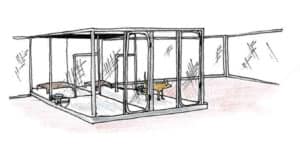CHAPTER SEVENTEEN
Pounds in communities
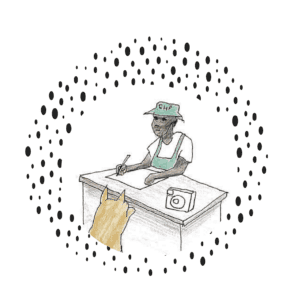
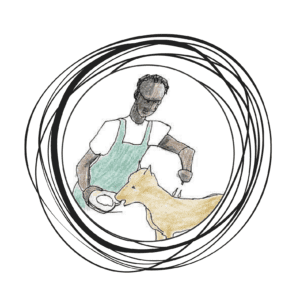
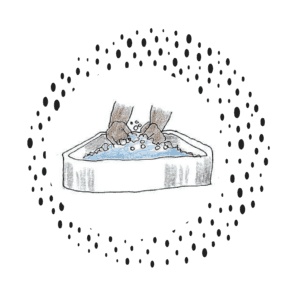
Pounds in communities
When they are well built and well run, pounds can be a useful addition to an animal health and management program. A pound or animal lock up area can also be very useful if a vet comes to the community to work.
But, if they are not built or run well, pounds can become a big animal welfare problem, and can cause stress and health risks for both the animals and people.
Not all communities will want or need a pound. It is a very full-on job running a pound and needs careful thought and planning from the community. There will also need to be a dedicated budget for the pound’s ongoing costs.
At the end of this chapter, there is a table listing pros and cons of running a pound.
Starting a pound
If your community is thinking about starting a pound, it is a good idea to go on a field trip to a working pound, to get ideas for how a pound could work in your community. The RSPCA often runs pounds in larger cities. There are also city council pounds.
If you are interested in visiting pounds to get ideas for your community, AMRRIC can help to link you up with the right people.
You can use the field trip to a pound to find out things like:
-
- How other places run their pounds
- How the paperwork is done
- Which cages work well
- How animals are fed and exercised
- How the pound and equipment is cleaned to stop diseases from spreading
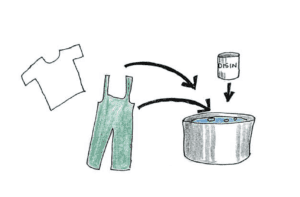
What will the pound be used for?
The main uses for a pound in a community are:
-
- Locking up dogs that are not registered.
- Locking up stray or problem dogs.
- Locking up a dog that has bitten a person. This can give the EHP time to find and talk to the owner.
If the building is big enough, it can also be used for things like:
-
- an office for the EHP
- a safe storage area for animal medicines used by the EHP
- a workplace for the vet when they visit
- a shop for selling animal health products
- a place where hydro-baths are given
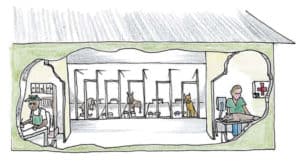
How big should the pound be?
How big the pound area needs to be depends on:
-
- how often it will be used
- what it will be used for
- how many dogs might need to be there at one time
- how long the dogs might have to stay
- how many staff will run the pound
Building a proper pound costs a lot of money and needs enough staff to make sure it can run 7 days a week.
Sometimes, sharing a pound with a nearby town or other community might be an option.
Things to plan before the community gets a pound
Building a pound is a big investment. If it isn’t planned well from the start, the pound might end up being a big problem.
Some of the things the community will need to plan include:
1. How will the animals get to the pound?
For a community to use a pound, they will also need a vehicle with animal cages.
The cages should be safe for the animals and the person using them, and should under shade.
It is good if the vehicle has storage for gloves, catch poles and other equipment the EHP might need to catch animals.
It’s also good if the vehicle has a water tank and tap, and some soap, so that the EHP can wash their hands after handling animals.
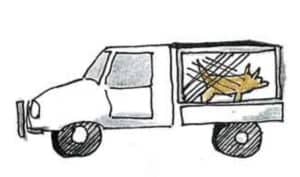
2. Where will the pound be located?
-
- Where do the traditional owners want the pound to be located?
- Where does the council want the pound to be located?
- Is the location secure? Will people be able to break in easily? Putting a pound too far away from town makes it easy to break into.
3. Does the pound need building approvals?
To build new pound, council may need to get:
-
- Development Application approval
- Environmental Impact Assessment approval
Different states and territories have different laws about what is needed.
Council management are the best people to plan this, and make sure the pound gets the right approvals.
If approvals are needed, they will look at things like:
-
- The plans and drawings for the buildings and the land boundaries.
- How the noise might affect people nearby.
- The source of the water supply to keep the pound clean
- Where the run-off wastewater from the pound will go
- What chemicals might be used in the pound and how these are stored and used.
- What animal waste will come out of the pound, and how the waste will be managed
4. How will the pound be staffed?
Whenever there are animals in the pound, staff need be working morning and afternoon, 7 days a week to make sure they are fed, watered, cleaned and exercised.
Even if dogs are in the pound over weekends or holidays, they will still need to be fed, watered, exercised and have their cages cleaned.
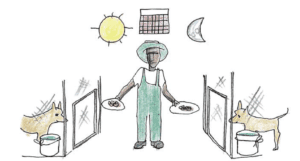
Making sure there are enough staff to cover each day (including weekends and holidays) is very important in running a pound.
If the pound is getting lots of animals through, there will probably also need to be more than one worker.
All staff working in the pound will need training in animal handling and reading animal body language. They will also need safety equipment like work boots, gloves and overalls. They should also talk to their doctor to make sure they are up to date with tetanus vaccinations, in case they are bitten by a dog.
5. How will the pound costs be funded?
Running a pound will always cost money.
Some of the ongoing costs include food for animals, cleaning products and building maintenance.
Councils that are running pounds might also need to pay the vet extra to treat impounded animals that are sick or injured.
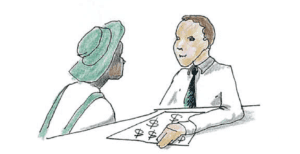
It is important to work out these ongoing costs before the pound is built, and make sure that there is enough money in the budget to cover them.
6. What guidelines should be followed?
There are many of organisations that have lots of experience building and running pounds and shelters.
Many of these organisations have developed guidelines that give recommendations for building and running a pound. The guidelines cover things like:
-
- cage design and minimum sizes
- numbers and types of animals that can be housed together
- animal exercise yard requirements
- materials that can be used to build the pound
- ventilation and temperature within the pound
- access to power, and hot and cold water
- food preparation area requirements
- isolation and cleaning procedures to stop diseases spreading within the pound
- management of animal waste and run-off
These guidelines are always being updated.
If your council is seriously considering starting a pound, it is important that they are aware of these guidelines, and build the pound so that it meets these recommendations.
RSPCA International’s Guidelines for the design and management of animal shelters has lots of useful information. The Victorian Government’s Code of Practice for the Operations of Shelters and Pounds also has lots of good recommendations.
AMRRIC can also recommend where else your council could get good information about starting and running a pound.
7. What will be done with animals that are not picked up from the pound?
Sometimes, the EHP will not be able contact an impounded animal’s owner. The owner might have moved to a new house, changed their phone number, or they might have even died.
Other animals might be unowned strays, or be surrendered by their owner because they are no longer wanted.
For some communities, euthanasia might be the only option for these unowned or unwanted dogs.
In some areas, instead of euthanasia, the community might be able to work with an animal rehoming group, and have the unowned or unwanted animals rehomed to towns or cities.
As the EHP, you can talk to your vet or AMRRIC about whether or not working with animal rehoming groups might be an option for unowned or unwanted pets in your community.
Before a pound is build, it is important for the council to have a plan for dealing with these animals.
Running a pound
Once the community has a pound, there are more things that need to be planned. These include:
1. What hours will the pound be open?
Some pounds have set opening times, when community members can visit and speak with staff.
Busy pounds are often open for 1 or 2 hours each morning and afternoon. This is the time when staff are there cleaning.
Owners can come during this time to sort out problems, pay fines and collect or surrender their animals.
If the pound is going to have set times of opening, it’s a good idea to advertise these opening hours on a sign on the pound gate.
2. What records need to be kept?
It is very important to keep good records of any animals that come through the pound.
These records are important for returning lost animals to their owners. They are also important for legal reasons, when there might be a dispute about the animal’s ownership or its behaviour.
Each animal that enters the pound should have a record created for it. This record should identify the animal and include details about when and why they were put in the pound.
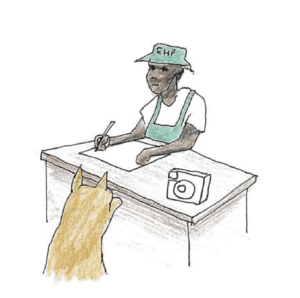
A photo can also be taken of the animal, and attached to the record.
This record might be a paper form or a record on a computer, tablet or phone.
The records need to be stored securely – either in a locked filing cabinet for paper forms, or on a password protected computer, tablet or phone.
Here is an example pound entry form from City of Palmerston Council. This form is kept with the dog while they are in the pound, and a copy is sent to the owner (if they are known).
Talk to your management about what sort of records you will need to keep for your community’s pound.
AMRRIC can also help to link you up with other organisations that can talk to you about how they run their pound and what records they keep.
3. How will the animals be identified?
Microchipping is the best way to identify animals.
Not all communities are doing this yet, but some are finding it very useful.
When an animal is microchipped, a small microchip, about the size of a grain of rice, is implanted under the skin of the animal with a big needle. It is usually placed between the shoulder blades of a dog or cat.
Each microchip has a special number. This number is entered into a computer registry that links this animal’s number with the name, address and phone number of the animal’s owner.
A special hand-held scanner is used to scan the microchip when the animal comes into the pound. Once the animal’s microchip has been scanned, the EHP can look up the computer registry to find the contact details for the animal’s owner. This helps re-unite animals with their owners.
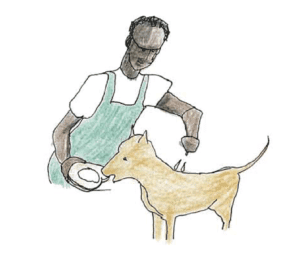
In some states and territories, a special licence is needed to implant microchips.
If this is something that the community would like to start doing, it is a good idea to talk to your vet about whether or not you will need to do training and get a license.
If microchipping is not available, there are other ways of identifying animals that are in the pound. These include collar tags, photos and descriptions of animals’ markings.
4. What needs to be done to stop the spread of diseases and parasites?
Because they can have lots of animals moving through them, pounds can become places where diseases like parvovirus and parasites build up.
All new animals should be checked for signs of sickness or injury. Any sickness or injury should be recorded on their entry forms, and the vet contacted to advise on treatments.
Good isolation and cleaning procedures are also important so that the pound doesn’t become a source of infection for diseases and parasites.
City pounds already have these procedures in place. AMRRIC can help you, as the EHP, to talk to staff who are already running pounds, about what needs to be done to stop the spread of diseases and parasites in your pound.
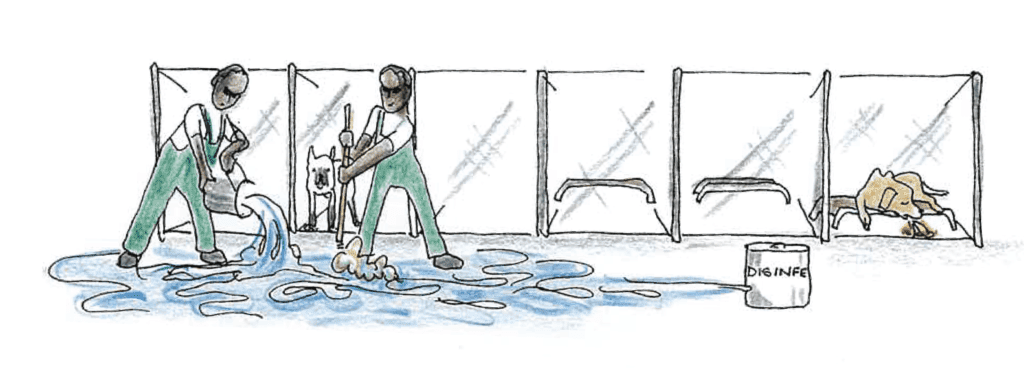
Pros = good things about pounds
-
- Pounds are a safe place to keep dogs that are roaming
- Pounds are a safe place to put animals that are not owned, or are unwanted
- By removing them from the community, pounds may reduce the risk of stray dogs fighting and biting people
- Pounds are a safe place to lock up a dog that has bitten a person, while the EHP finds and talks to the owner about what need to happen with the dog
- Part of the pound can be used as a place to quarantine & treat sick or injured animals
- An office for the EHP can be attached to the pound
- A shop to sell medicine can be attached to the pound
- Pounds can be a good place for the vet to work from
Cons = bad things about pounds
-
- Pounds can be expensive to build, run and maintain
- Building a pound requires careful planning and can require a lot of building approvals
- Waste from the pound will need to be carefully planned managed
- When there are animals in the pound, there needs to be staff at the pound every day (including weekends and holidays) to feed, water and exercise them
- Pounds have lots of ongoing costs, and can be expensive to run
- If they are not built well, or if animals aren’t getting enough attention, pounds can cause big animal welfare problems
- Without careful quarantine and cleaning procedures, disease can build up in the pound, and spread between animals
- There is lots of paperwork that is needed to run a pound properly
- Dogs barking can be very noisy, so if the pound is in the community, neighbours might complain
- Pounds can be a target for break-ins, so need to have good security
- Animals can’t stay in pounds forever – if they can’t be rehomed, some animals in the pound might need to be euthanased.
